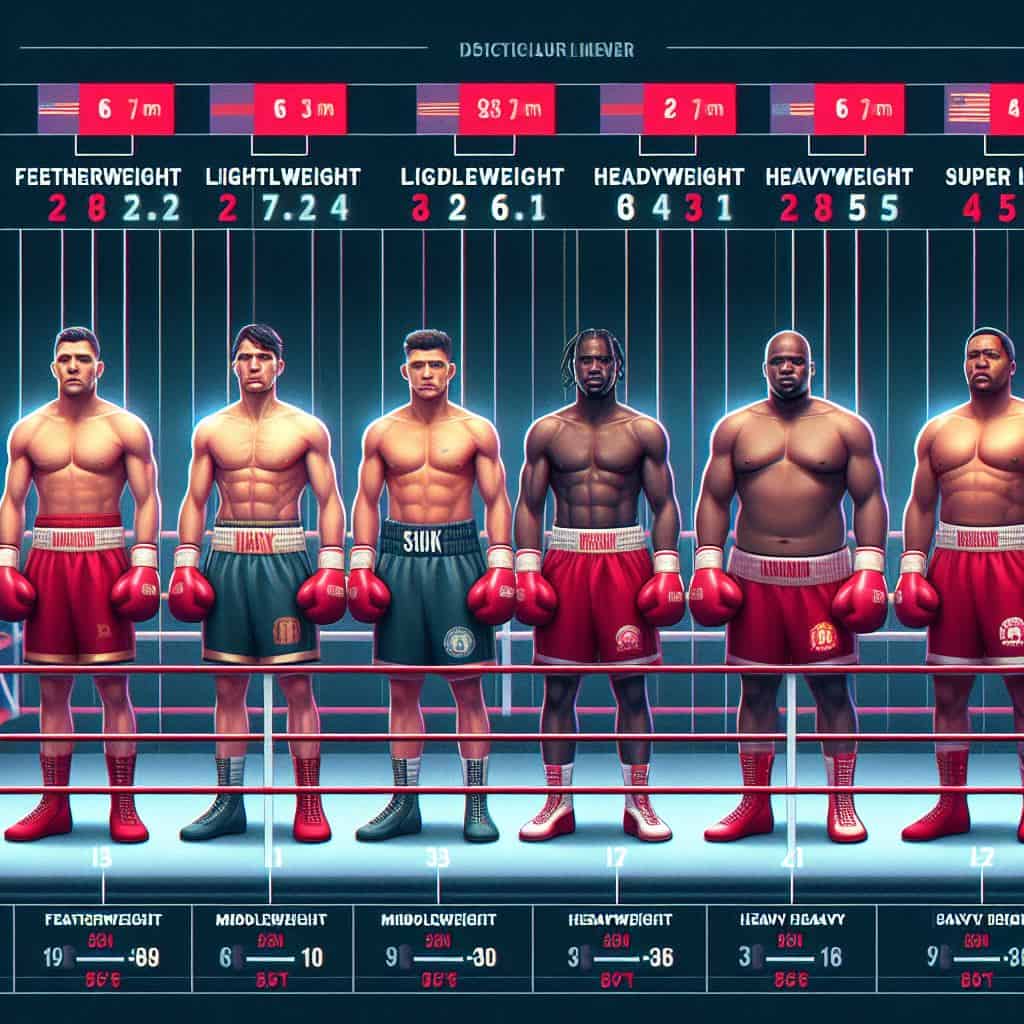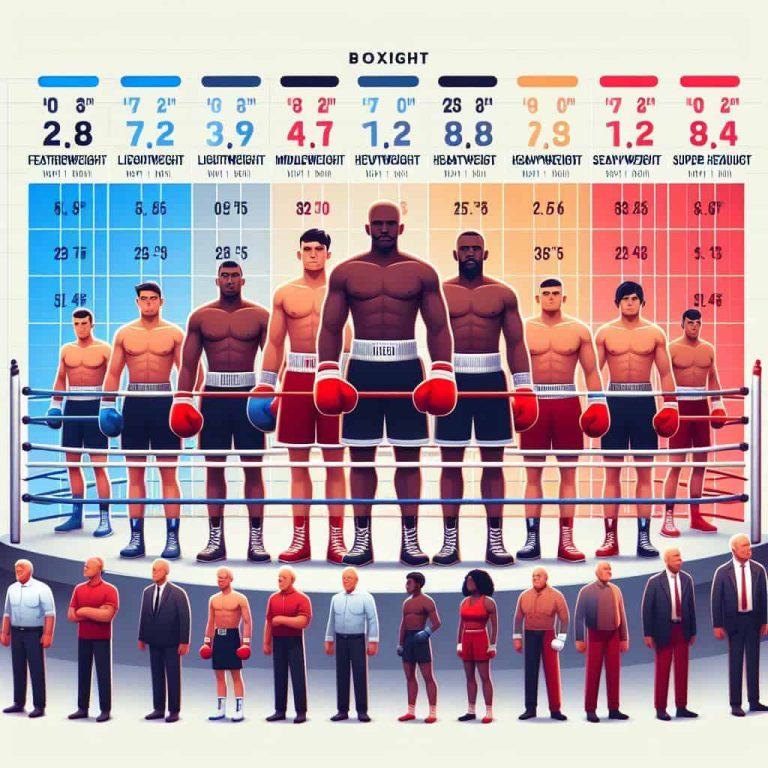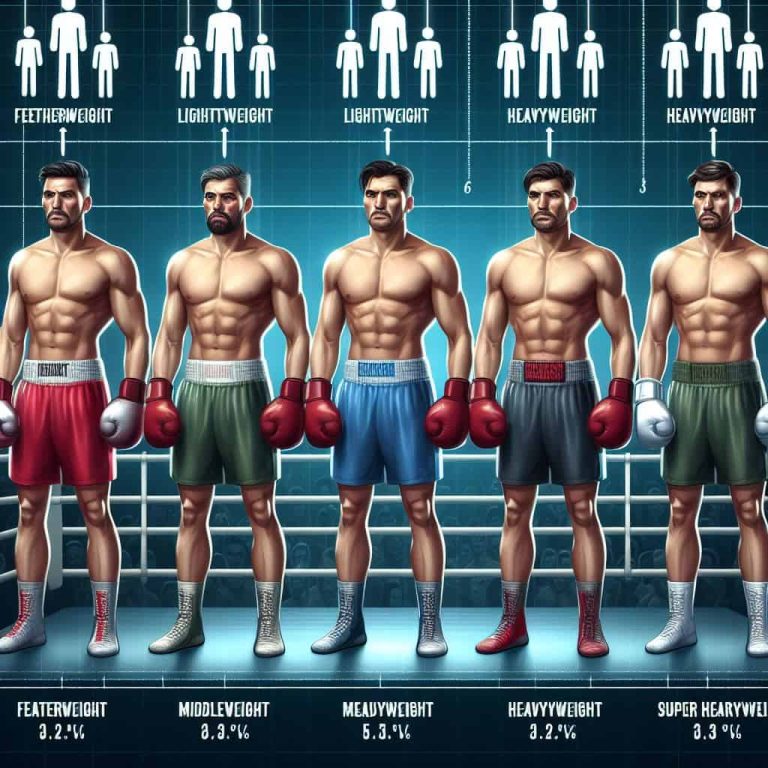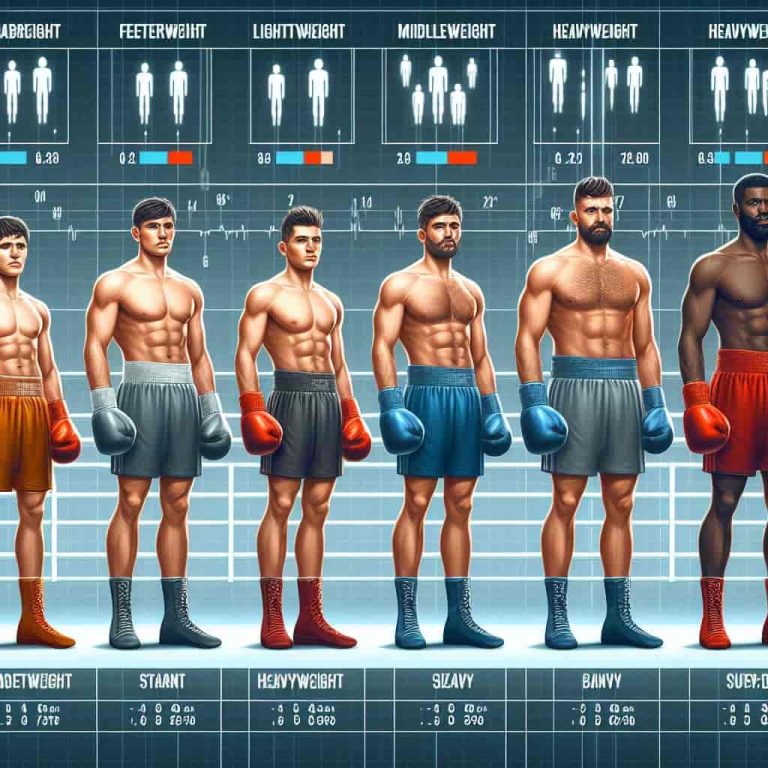Boxing Weight Classes
Boxing, a sport that demands precision, strength, and agility, is organized into various weight classes to ensure fair competition. These weight classes categorize boxers based on their body weight, allowing them to compete against opponents of similar size and strength.
Boxing weight classes chart for different weight range are given in tabular form in kilograms (kg) and in pounds (lb) below:
| Weight Class | Weight Range (in pounds) | Weight Range (in kilograms) |
|---|---|---|
| Heavyweight | Over 200 | Over 90.72 |
| Cruiserweight | 200 and under | Up to 90.72 |
| Light Heavyweight | 175 and under | Up to 79.38 |
| Super Middleweight | 168 and under | Up to 76.20 |
| Middleweight | 160 and under | Up to 72.57 |
| Super Welterweight | 154 and under | Up to 69.85 |
| Welterweight | 147 and under | Up to 66.68 |
| Super Lightweight | 140 and under | Up to 63.50 |
| Lightweight | 135 and under | Up to 61.23 |
| Super Featherweight | 130 and under | Up to 58.97 |
| Featherweight | 126 and under | Up to 57.15 |
| Super Bantamweight | 122 and under | Up to 55.34 |
| Bantamweight | 118 and under | Up to 53.52 |
| Super Flyweight | 115 and under | Up to 52.16 |
| Flyweight | 112 and under | Up to 50.80 |
| Light Flyweight | 108 and under | Up to 49.00 |
| Minimumweight | 105 and under | Up to 47.63 |
| Fact/Figure | Description |
|---|---|
| Number of Weight Classes | There are currently 17 recognized weight classes in professional boxing. |
| Maximum Weight Difference | The maximum weight difference between opponents in the same weight class is minimal to ensure fair competition. |
| Smallest Weight Difference | In some weight classes, the difference in weight between opponents can be as small as a few pounds. |
| Weight Class with Most Champions | Historically, the welterweight division has produced the most champions across different eras. |
| Number of Major Boxing Organizations | Several major boxing organizations, including the WBC, WBA, IBF, and WBO, sanction and regulate weight classes. |
| Weight Class Changes Throughout History | Over the years, the number and names of weight classes have evolved to adapt to changes in the sport and fighter demographics. |
| Regional Variations in Weight Class Names | While the basic weight divisions are consistent globally, some regions may have unique names for certain weight classes. |
| Age and Weight Class Eligibility | Boxers must meet both age and weight requirements to compete in specific weight classes, ensuring safety and fairness. |
| Unified Champions Across Weight Classes | Some elite boxers have achieved the rare feat of becoming unified champions in multiple weight classes, showcasing their exceptional skill and versatility. |
History and Evolution of Boxing Weight Classes
The concept of weight classes in boxing dates back to the late 19th century, where matches were often arranged without regard to weight, leading to mismatches and unfair fights. Over time, governing bodies recognized the need for standardized weight divisions to level the playing field and enhance the sport’s integrity.
Importance of Weight Classes in Boxing
Weight classes play a crucial role in boxing by providing structure and organization to the sport. They ensure that boxers compete against opponents of comparable size, reducing the risk of injury and creating more exciting and competitive matches.
How Boxing Weight Classes are Determined
Boxing weight classes are determined by the maximum weight limit for each division, with boxers weighing in before their fights to ensure compliance. These weight limits are set by sanctioning bodies such as the World Boxing Council (WBC), International Boxing Federation (IBF), and World Boxing Association (WBA).
Major Boxing Organizations and Their Weight Class Divisions
Various boxing organizations, including the WBC, IBF, WBA, and World Boxing Organization (WBO), oversee different weight class divisions. Each organization may have slight variations in weight limits and regulations for their respective divisions.
Differences Between Professional and Amateur Boxing Weight Classes
While both professional and amateur boxing have weight classes, there are differences in the number and distribution of divisions. Professional boxing typically offers a broader range of weight classes, catering to a wider spectrum of boxers, whereas amateur boxing often has fewer divisions.
Popular Boxing Weight Classes and Their Champions
Some of the most popular boxing weight classes include heavyweight, welterweight, middleweight, and featherweight. Each division has produced legendary champions who have left an indelible mark on the sport.
Challenges and Controversies in Boxing Weight Classes
Despite their intended purpose, boxing weight classes are not without challenges and controversies. Issues such as weight cutting, where boxers dehydrate themselves to make weight, and discrepancies in judging can impact the fairness of matches.
Impact of Weight Cutting on Boxers’ Health
Weight cutting, a common practice in combat sports, can have detrimental effects on boxers’ health, including dehydration, diminished performance, and increased risk of injury. Regulating weight cutting practices is essential to safeguarding boxers’ well-being.
Strategies for Boxers to Compete in Different Weight Classes
Some boxers opt to move across weight classes throughout their careers, employing strategic training and dietary techniques to meet the weight requirements of different divisions. This flexibility allows them to pursue championship opportunities in multiple weight classes.
Famous Boxers Who Moved Across Weight Classes Successfully
Several iconic boxers have successfully transitioned between weight classes, demonstrating their versatility and skill. From Muhammad Ali to Manny Pacquiao, these athletes have conquered multiple divisions, cementing their legacy in boxing history.
The Future of Boxing Weight Classes
As the sport of boxing continues to evolve, so too may the landscape of weight classes. Changes in training methods, nutrition science, and medical understanding may influence how weight classes are structured and regulated in the future.
Conclusion
Boxing weight classes serve as the backbone of the sport, ensuring fair competition and promoting the safety and well-being of its participants. While challenges persist, the ongoing evolution of weight class regulations aims to uphold the integrity and excitement of boxing.
FAQs on Boxing Weight Classes
- What is the purpose of weight classes in boxing? Weight classes in boxing ensure fair competition by grouping boxers of similar size and strength together, reducing the risk of mismatches.
- How often do boxers change weight classes? Boxers may change weight classes throughout their careers, depending on factors such as age, skill level, and competitive opportunities.
- Can a boxer compete in multiple weight classes simultaneously? While rare, some boxers may compete in multiple weight classes simultaneously, particularly if they possess the skill and versatility to do so.
- What happens if a boxer misses the weight limit for their class? If a boxer fails to make weight, they may face penalties such as fines, forfeiture of titles or rankings, or the cancellation of the fight altogether.
- Are there weight classes for female boxers? Yes, female boxers also compete in weight classes, with divisions mirroring those of male boxers to ensure equitable competition.




